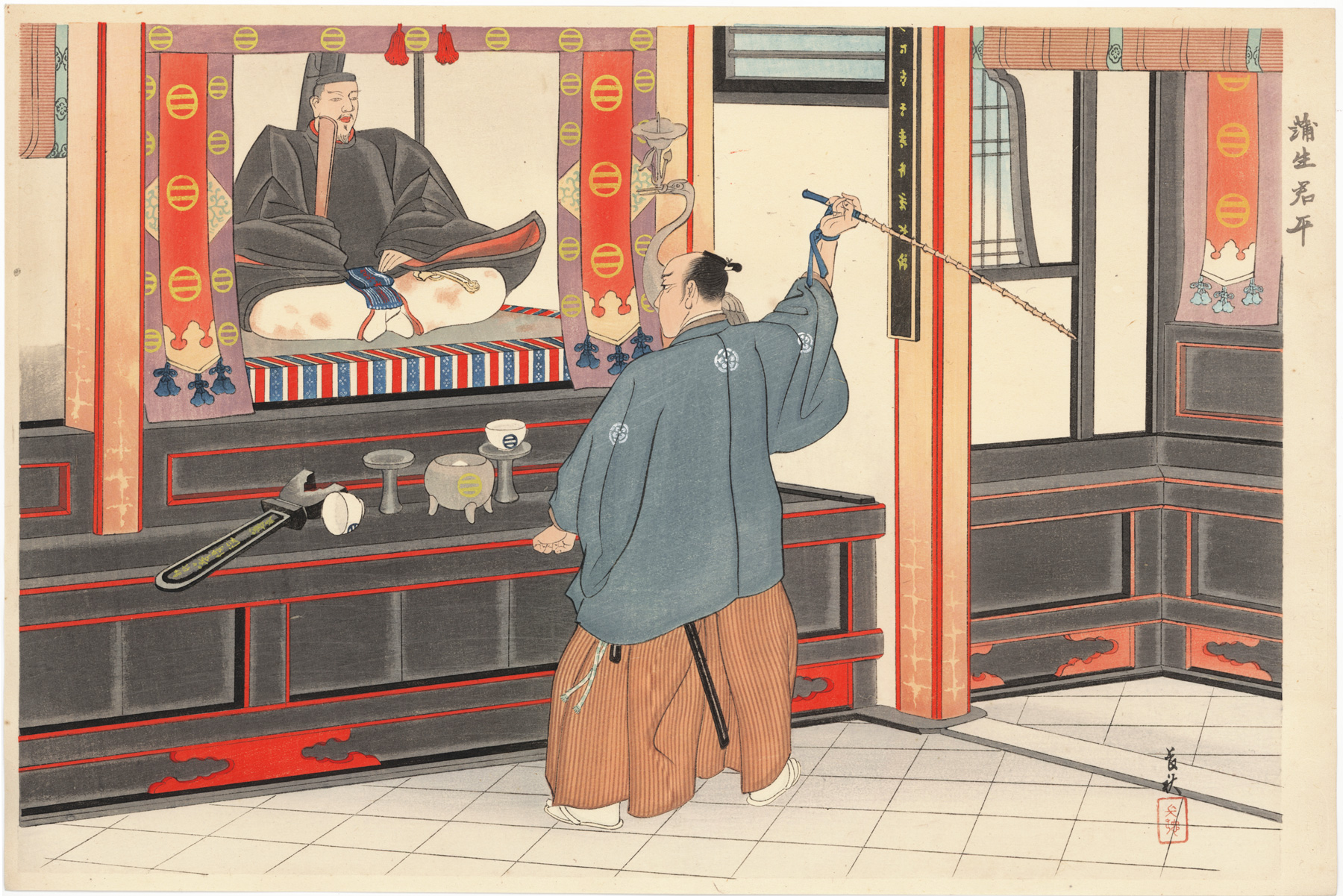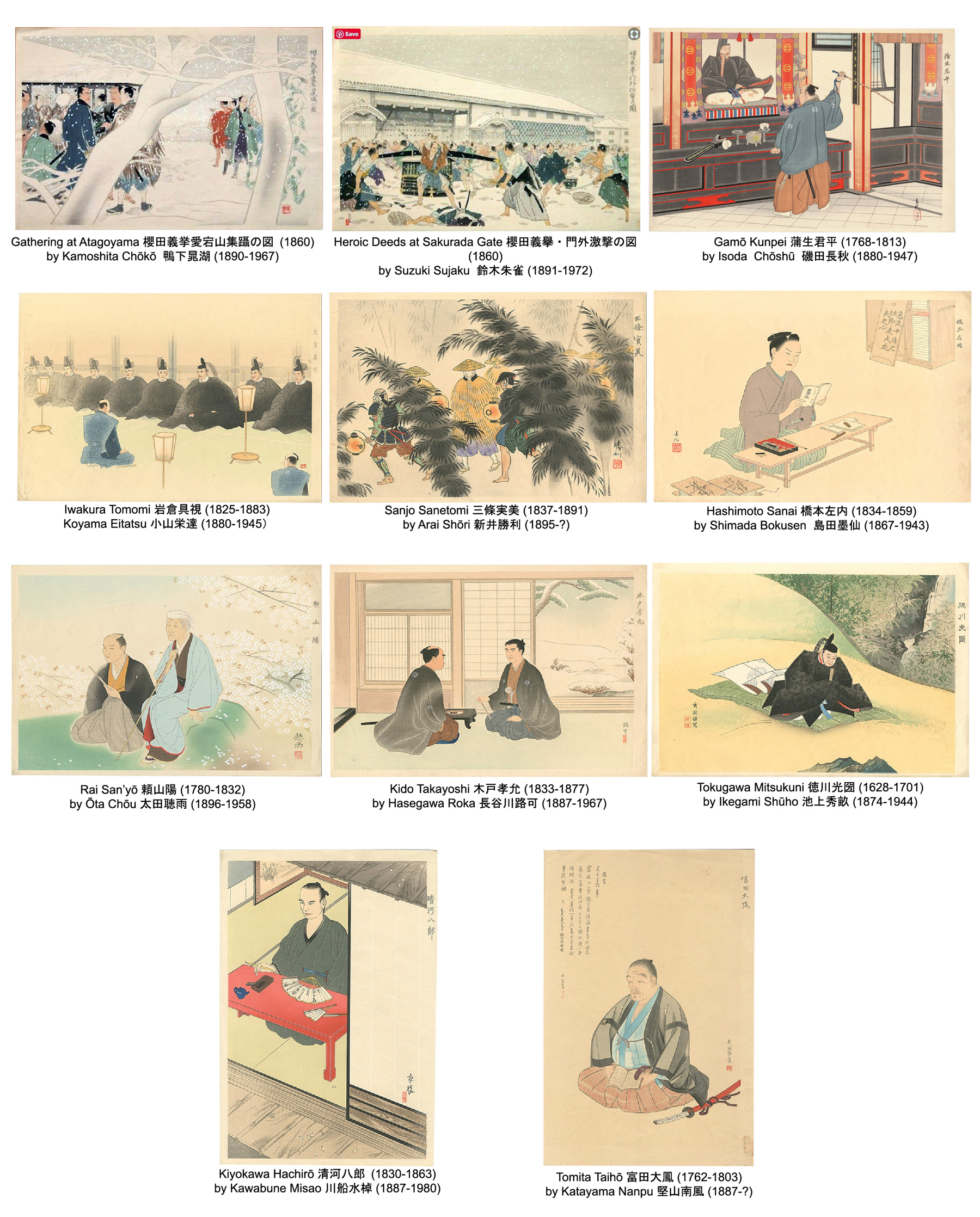About This Print
Isoda constructs this fictional scene showing the writer and nationalist Gamō Kunpei castigating the Tokugawa shogun about the poor state of the Imperial Tombs he surveyed in the late 18th century. Gamō subsequently published the "Sanryō shi" (Record of the Imperial Tombs) in 1808.About Gamō Kunpei
Gamō Kunpei 蒲生君平 (1768-1813) was born in 1768 to a merchant family inUstunomiya, present day Tochigi prefecture. His common name was Isaburo,familiar name Kunzo or Kunpei, pen name Shusei or Shusei-an. Along withTakayama Hikokurō and Hayashi Shihei, he is known as one of the "ThreeEccentrics of the Kansei Era" who are credited with the beginnings of therise of nationalism in Japan.
During the Kansei Era, in the late 18th Century, he researched all of Japan's imperial tombs and compiled the "Sanryō shi" (Record of theImperial Tombs) in 1808. This work is now known as one of the pioneeringefforts of the Imperial Loyalist Theory. He later came to Edo, worked on his writings, and died in 1813. He isknown as an advocate of the sonnō jōi doctrine1. His gravewas Selected in 1942 as a national historic site.
About The Series Thirty Great Loyalists of Early Modern Times 近世勤皇家三十傑
This series of thirty prints titled Thirty Great Loyalists of Early Modern Times depicts figures active in the mid/late Edo through Meiji eras who displayed great loyalty to the Emperor and, thereby, the nation. Issued in 1942 when the war in the Pacific was raging, the patriotic theme of these prints was clear.  Watanabe "G" type seal embossed on margin of some prints (reproduced "G" type seal on left for clarity) |  embossed seal on margin reading 勤皇文化振興會 Kinnō bunka shin kōkai [Society for the Promotion of Loyalist Culture] | The series was conceived under the direction of the patriotic organization Kinnō bunka shinkōkai (Society for the Promotion of Loyalist Culture), about which little is known.2 For some of the prints in the series, the Society collaborated with the publishing business of Watanabe Shōzaburō, as Watanabe's "G" type seal is embossed in the margin, in addition to the embossed seal of the Society, both shown to the left. From the series' name we can assume that thirty prints were planned, although I could only locate eleven prints through a web search, which are pictured below. All of the artists for the eleven prints were nihonga (Japanese-style) painters and their involvement might either indicate their patriotism or just a desire to stay in the good graces of the authorities during a time when artistic freedom was being greatly curtailed and artistic output directed to serve the war effort. While painting, particularly realistic looking Western painting in large formats, was the cutting edge of war art, prints served as the soft-propaganda media, focusing on building patriotism and support for the war effort on the home front. For a further explanation of the role of woodblock prints in the war effort see Prints During the War Years 1937-1945, the Occupation (and beyond). |
1 sonnō jōi, the movement “to revere the emperor and repel the barbarians” which came to prominence after the 1858 signing of the Treaty of Amity and Commerce with the United States by the shogunate without the approval of the emperor. Followers of the movement murdered the Shogun's chief minister, Lord Ii Naosuke, in 1860 outside the Sakurada palace gate on a snowy morning, a subject of two other prints in this series. When the movement's goal of expelling all barbarians (i.e. Westerners) from Japan became impossible, the movement directed its energy to overthrowing the shogunate and opening up Japan.
2 The Society published a book in 1941 with the title 勤皇文化振興会 : 性質と事業 and the website of the Meiji Jingu Shrine in their chronology notes that in 1971 the received some works (possibly calligraphic works) collected by the Society. [source: https://www.rekishidb.meijijingu.or.jp/chronology/era_detail.php?year=1971&month=5]
Print Details
IHL Catalog #1967 Title Gamō Kunpei 蒲生君平 Series Thirty Great Loyalists of Early Modern Times 近世勤皇家三十傑 Artist Isoda Chōshū (1880-1947) Signature Seal unread seal as shown above Publication Date 1942 Edition Publisher embossed in right margin
不許複製 all rights reserved
勤皇文化振興會 Kinnō bunka shin kōkai [Society for the Promotion of Loyalist Culture]ナガヤ作 [nagaya saku] 東々五八八 [toto? 588]
note: The significance of this oval seal beneath the Kinnō bunka shin kōkai seal which appears on several prints in this series is unknown. It might be a publisher's seal, as this print does not carry the Watanabe seal as do other prints in the series.Carver unknown Printer unknown Impression excellent Colors excellent Condition excellent Genre nishiki-e Miscellaneous Format ōban H x W Paper 9 11/16 x 15 in. (24.6 x 38.1 cm) H x W Image 9 1/2 x 14 1/4 in. (24.1 x 36.2 cm) Collections This Print Reference Literature
last update:
3/28/2019 created





